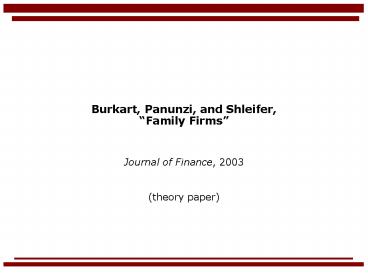Burkart, Panunzi, and Shleifer, Family Firms - PowerPoint PPT Presentation
1 / 18
Title:
Burkart, Panunzi, and Shleifer, Family Firms
Description:
Pro manager's opportunity cost (outside option net of foregone amenity potential) ... Amenity potential is too high. Ownership and management ALWAYS separated ... – PowerPoint PPT presentation
Number of Views:69
Avg rating:3.0/5.0
Title: Burkart, Panunzi, and Shleifer, Family Firms
1
Burkart, Panunzi, and Shleifer, Family Firms
- Journal of Finance, 2003
- (theory paper)
2
Motivation and Contributions
- Family control is pervasive around the world
- Need to combine in one unified framework the twin
conflicts - manager outside owners
- large shareholder minority shareholders
- Examine the decision to separate ownership from
control (management) vs. succession (a choice
variable in this model) - Consider collusion and non-collusion between the
founder and professional manager
3
Existing Theories on the benefits of preserving
family control
- Imperfect Capital Markets
- Bhattacharya Ravikumar (2001, 2002)
- Amenity potential
- introduced by Demsetz Lehn (1985)
- nonpecuniary private benefits of control
- does NOT come at expense of profits
- Family name adds value
- Reputation
- Political Connections - Faccio (2002)
- Expropriation
- classical Jensen Meckling (1976)
- private benefits of control are at expense of
profits (minority shareholders)
4
Model Outline
- Founder looking for a manager to succeed him
- retiring, etc.
- recognizes own inferior abilities to run the firm
(consistent with empirical evidence Morck et
al./ (2000), Perez-Gonzales (2001)) - equivalent to There exists a better qualified
manager - NO superior manager with sufficient resources to
buy the firm outright - Founder has 3 options
- sell out completely
- hire a pro manager AND retain control to monitor
- keep the firm in the family
- Founder max-s own welfare
- retained block
- revenues from sold shares
- amenity potential
5
Model anchors and key assumptions
- trade-off b/w superior pro manager and discretion
to expropriate - level of legal protection of outside owners
determines the maximum possible degree of
expropriation - legal protection (measured by ) vs. efficiency
of monitoring (k) - substitutes
- complements k
- firm size is exogeneous, no investment decision
considered - direct collorary If the founder is the best
manager, then no shares are sold and there are no
agency problems. - firm cannot opt into more protective legal regime
via a contract, such as cross-listing or a better
corporate charter.
6
Time line
The models is solved by backwards induction.
7
Notation 1
8
Notation 2
9
Solution under non-separation
- ownership structure is indeterminate
- founders welfare is independent of legal
environment - the sum of security and private benefits is
constant
10
Solution under non-collusion
11
Detailed Solution under non-collusion (Lamma 2) 1
12
Detailed Solution under non-collusion (Lamma 2) 2
13
Overall equilibrium (compare VNS and VS) for B at
extremes (Prop 1)
- Within a country (legal protection is const.)
- founder may find it optimal to keep control even
with very strong protection (US media, sports
companies) - founder hires a pro manager if sufficiently
incompetent (W. Europe utilities and telecoms)
14
Overall equilibrium (compare VNS and VS) for
moderate B (Prop 2)
15
Figure 2
16
Definition of C0, C1 and C2
17
Additional results
- main problem with models predictions
- under separation founders block trades at a
discount - stems from monitoring being a public good (free
rider problem)
18
Figure 3































